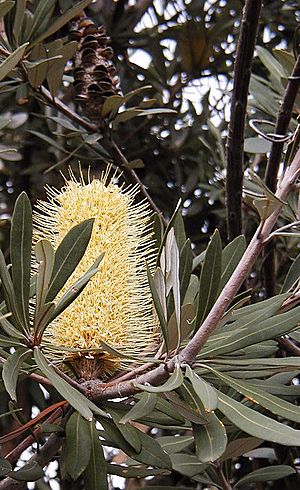Banksia sect. Eubanksia facts for kids

Banksia sect. Eubanksia was an old way of grouping different types of Banksia plants. Think of it like an old-fashioned folder for certain Banksia species. This grouping isn't used anymore today. Over time, botanists (scientists who study plants) changed their minds about which plants belonged in this group.
There were two main ideas about what Eubanksia meant. One idea was very similar to a group called B. subg. Banksia that was also recently stopped being used. The other idea for Eubanksia is completely different from any modern plant grouping.
Contents
What is Eubanksia?
The name Eubanksia first appeared in 1847, used by a botanist named Stephan Endlicher. He used it as a new name for a group that Robert Brown had earlier called Banksia verae. This name meant "true banksias."
Robert Brown's Original Idea
In Robert Brown's system, Banksia verae included all Banksia species that had a typical flower spike. This meant almost all known Banksia plants at the time. The only one left out was the B. ilicifolia (Holly-leaved Banksia), which was unusual because its flowers grew in a dome shape instead of a spike.
How Endlicher and Meissner Used the Name
Stephan Endlicher kept Robert Brown's idea for what belonged in Eubanksia. Later, in 1856, another botanist named Carl Meissner also used the name Eubanksia and made it an official "section" in his plant classification system. Meissner then divided this B. sect. Eubanksia into four smaller groups based on the shapes of their leaves. These smaller groups were called Abietinae, Salicinae, Quercinae, and Dryandroideae.
George Bentham's Different View
In 1870, a botanist named George Bentham came up with his own way of classifying Banksia plants. He divided Banksia into five sections. He also used the name B. sect. Eubanksia, but his idea of what belonged in it was very different!
Bentham's B. sect. Eubanksia only included three species:
- B. marginata (Silver Banksia)
- B. dentata (Tropical Banksia)
- B. integrifolia (Coast Banksia)
He believed these three species were so similar that they could almost be seen as different types of the same plant. So, Bentham's idea of Eubanksia had nothing to do with what Brown, Endlicher, and Meissner had thought.
Why Eubanksia is Not Used Anymore
The name B. sect. Eubanksia stopped being used in 1981. This happened when Alex George published his new classification system for Banksia plants.
Alex George's System
Alex George went back to the original idea of Brown, Endlicher, and Meissner for the group. However, by this time, the rules for naming plants had changed. Because of these rules, Robert Brown's original Banksia verae had to be called B. subg. Banksia. This means that Endlicher's Eubanksia and Meissner's section Eubanksia are now considered the same as B. subg. Banksia in Alex George's system.
This classification was kept in later systems by other botanists like Thiele and Ladiges in 1996, and again by George in 1999. But in 2007, the group B. subg. Banksia was finally stopped being used when Austin Mast and Kevin Thiele published their new system.
Bentham's Eubanksia Today
On the other hand, George Bentham's idea of B. sect. Eubanksia doesn't match any modern plant groups. The three species he placed in that section are now grouped differently. Alex George placed all three of them in a group called B. ser. Salicinae. This was also kept in Thiele and Ladiges' system. However, this group contains many other species, and the three species Bentham thought were so close are not considered especially related today.

